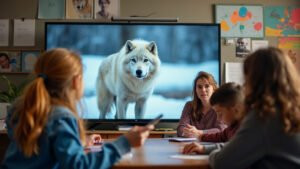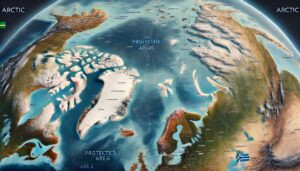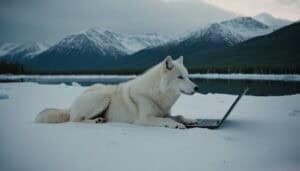Introduction
Teaching students about Arctic wolves can be an exciting and engaging experience when done through interactive lessons
This article explores various methods educators can use to create dynamic and informative lessons about Arctic wolves. From understanding their key characteristics and habitats to integrating technology and interactive activities, educators will find practical strategies and resources to enhance their teaching
We will also cover effective assessment techniques to ensure students grasp the material comprehensively
Understanding Arctic Wolves
Learning about Arctic wolves involves understanding their unique characteristics and behaviors, which differentiate them from other wolf species. By exploring these aspects, students can gain a deeper appreciation for these fascinating creatures and their adaptation to harsh environments
Key Characteristics of Arctic Wolves
Arctic wolves, also known as Canis lupus arctos, are a subspecies of the gray wolf that inhabit the Arctic regions of North America and Greenland. They have several distinct features that enable them to survive in extreme cold and harsh conditions
One of the most notable characteristics of Arctic wolves is their thick, white fur, which provides insulation against freezing temperatures and helps them blend into the snowy environment, offering camouflage from both prey and predators. The fur of Arctic wolves consists of two layers: a dense, insulating undercoat and a coarse, protective outer coat. This double-layered fur allows them to withstand temperatures as low as -30°C (-22°F)
Arctic wolves are generally smaller than their gray wolf counterparts. Adult males typically weigh between 85 to 155 pounds, while females are slightly smaller, weighing between 80 to 130 pounds. Their shorter legs, ears, and muzzles also help minimize heat loss, an adaptation crucial for survival in the Arctic
Another distinctive feature is their diet. Arctic wolves primarily hunt muskoxen and Arctic hares, but they are opportunistic feeders and will eat other available prey, including lemmings, birds, and even seals. Due to the scarcity of prey in their habitat, Arctic wolves have adapted to travel long distances, sometimes over 600 miles in a year, in search of food
In terms of behavior, Arctic wolves are known for their pack dynamics. Packs are typically smaller than those of gray wolves, often consisting of a family unit with a dominant breeding pair and their offspring. This close-knit structure is essential for cooperative hunting and raising pups, especially in an environment where resources are limited
Habitat and Behavior
The habitat of Arctic wolves is primarily the tundra and icy regions where few other predators exist
These areas are characterized by extreme cold, permafrost, and a lack of vegetation, challenging the survival of any species. Arctic wolves have adapted remarkably to these conditions through both their physical and behavioral traits
During the breeding season, which occurs from March to April, Arctic wolves establish dens in sheltered areas such as caves, rock outcroppings, or dug-out burrows in the ground. These dens provide protection for their pups from the elements and predators. A typical litter consists of 2 to 4 pups, which are cared for by the entire pack
Arctic wolves are also known for their social structure and communication methods. They use a variety of vocalizations, body language, and scent marking to communicate with each other and establish territories. Howling is a common behavior that serves multiple purposes, such as rallying the pack, signaling their location, or deterring intruders
The harsh environment also influences their hunting strategies. Arctic wolves often hunt in packs, employing coordinated tactics to take down larger prey like muskoxen, which can be dangerous and difficult to catch. The pack’s cooperative nature and strong social bonds are crucial for their survival, as successful hunts depend on teamwork and precise coordination
Overall, understanding the key characteristics and behaviors of Arctic wolves provides valuable insights into how these animals have adapted to thrive in one of the most challenging environments on Earth. This knowledge can help educators create more engaging and informative lessons, fostering a deeper appreciation for Arctic wildlife among students
Integrating Technology and Resources
Integrating technology and a variety of educational resources into lessons about Arctic wolves can significantly enhance student engagement and understanding. Using smartboards, multimedia, online resources, virtual tours, and recommended readings can make the learning experience more dynamic and interactive
Using Smartboards and Multimedia
Smartboards and multimedia tools are invaluable in creating interactive lessons about Arctic wolves. These technologies can bring the Arctic environment into the classroom, making the subject more tangible and exciting for students
Smartboards allow educators to display high-resolution images and videos of Arctic wolves, their habitats, and their behaviors. For instance, a teacher could show a documentary clip of Arctic wolves hunting or caring for their pups, which can spark discussions and deepen students’ understanding of these animals’ daily lives
Additionally, smartboards can be used for interactive activities such as quizzes, games, and virtual dissections, helping students retain information more effectively
Multimedia presentations can also include sound bites of wolf howls and other vocalizations, providing an auditory element that can make the lessons more immersive. Teachers can create slideshows with annotated maps showing the geographical range of Arctic wolves, highlighting key areas where they are found. This visual and auditory stimulation helps cater to different learning styles, ensuring that all students can engage with the material
Online Resources and Virtual Tours
The internet offers a wealth of resources for teaching about Arctic wolves. Online databases, wildlife organization websites, and educational platforms provide up-to-date information and interactive tools that can be integrated into lesson plans
One valuable resource is the National Geographic Kids website, which offers articles, videos, and educational games about Arctic wolves and other wildlife. Similarly, the World Wildlife Fund (WWF) website provides in-depth information on the conservation status and efforts related to Arctic wolves, which can be used to discuss broader environmental issues and the importance of biodiversity
Virtual tours are another powerful tool. Websites like Explore.org offer live cams that allow students to observe Arctic wolves in their natural habitats in real-time. These virtual field trips can make the learning experience more engaging and realistic, allowing students to see behaviors and interactions that they would not otherwise be able to witness
Additionally, virtual reality (VR) experiences can transport students to the Arctic, providing a 360-degree view of the wolves’ environment and fostering a deeper connection to the subject matter
Resources for Educators
Providing educators with a variety of resources is crucial for developing comprehensive and engaging lessons about Arctic wolves. Recommended reading materials, websites, and professional development opportunities can enhance teachers’ knowledge and instructional strategies
Recommended Reading and Websites
Books and reputable websites offer a wealth of information that can be integrated into lesson plans
Here are some essential resources:
Books
“Arctic Wolves: Life in the Packs” by Meish Goldish: This book provides detailed insights into the lives of Arctic wolves, making it a great resource for both educators and students
“The Arctic Wolf: Living with the Pack” by L. David Mech: Renowned wolf expert David Mech shares his experiences and observations from studying Arctic wolves in their natural habitat. This book offers a deep dive into wolf behavior and ecology
Websites
International Wolf Center (wolf.org): This website offers extensive information on wolf biology, behavior, and conservation. It includes educational resources such as lesson plans, fact sheets, and videos that can be incorporated into classroom teaching
National Geographic Kids (kids.nationalgeographic.com): This site provides engaging articles, videos, and games about Arctic wolves and other wildlife. It’s a great resource for interactive and multimedia-based learning
World Wildlife Fund (worldwildlife.org): The WWF website offers in-depth information on the conservation status of Arctic wolves and broader environmental issues. Educators can use this site to discuss the importance of biodiversity and conservation efforts
Professional Development Opportunities
For educators, professional development programs focused on Arctic wolves and wildlife education can provide valuable insights and strategies
Here are some opportunities:
Workshops and Seminars
International Wolf Center Workshops: The International Wolf Center offers workshops and seminars for educators, covering topics such as wolf biology, behavior, and conservation. These programs provide hands-on learning experiences and teaching resources
National Association of Biology Teachers (NABT) Conferences: Attending NABT conferences allows educators to participate in sessions focused on wildlife education, including presentations by experts in the field
Online Courses
Coursera and edX: Platforms like Coursera and edX offer online courses on wildlife conservation, ecology, and environmental science. Courses such as “Ecology: Ecosystem Dynamics and Conservation” provide foundational knowledge that can be applied to teaching about Arctic wolves
Project WILD: This environmental education program offers online training for educators, providing resources and activities focused on wildlife and ecosystems. The program’s materials are designed to be easily integrated into classroom teaching
Networking and Collaboration
Professional Organizations: Joining professional organizations such as the North American Association for Environmental Education (NAAEE) or the National Science Teachers Association (NSTA) can provide access to resources, conferences, and a network of peers. Collaborating with other educators can lead to the development of innovative lesson plans and activities
Social Media and Online Communities: Participating in online communities, such as educational groups on social media platforms like Facebook or LinkedIn, allows educators to share resources, ask questions, and exchange ideas with colleagues from around the world
By utilizing these recommended reading materials, websites, and professional development opportunities, educators can enhance their knowledge and instructional skills. Access to diverse and reliable resources ensures that teachers can create engaging and informative lessons about Arctic wolves, fostering a deeper understanding and appreciation for these remarkable animals among students
Interactive Activities and Engagement
Engaging students in interactive activities is crucial for deepening their understanding of Arctic wolves. Hands-on projects, simulations, storytelling, and role-playing are effective methods to make the learning process active and immersive
Hands-On Projects and Simulations
Hands-on projects allow students to explore the lives of Arctic wolves through creative and practical activities. These projects can range from building models to conducting experiments, each designed to help students understand the physical and behavioral adaptations of Arctic wolves
One hands-on project could involve students creating dioramas of the Arctic habitat. Using materials such as clay, paper, and paint, students can construct a 3D model that includes elements like snow, ice, and terrain features. They can then place miniature figures of Arctic wolves and their prey within the diorama to represent the ecological dynamics of the region
Simulations provide another powerful tool for learning
For instance, students can participate in a role-playing game where they assume the roles of Arctic wolves. This game could involve scenarios such as hunting for food, caring for pups, or defending territory from intruders. By engaging in these activities, students gain a deeper understanding of the challenges Arctic wolves face and the strategies they use to survive
Teachers can also use computer simulations to illustrate the effects of environmental changes on Arctic wolf populations
Programs like EcoSim or WolfQuest allow students to manipulate variables such as prey availability, temperature, and human encroachment, observing how these factors impact wolf behavior and survival. These simulations encourage critical thinking and problem-solving, helping students grasp complex ecological concepts
Storytelling and Role-Playing
Storytelling is a powerful tool for teaching about Arctic wolves
By weaving factual information into engaging narratives, educators can capture students’ imaginations and make the material more memorable. Teachers can read books or share stories about famous Arctic wolves, such as the “White Wolf” who led a pack in Greenland, highlighting their adventures and struggles
Role-playing activities can further enhance engagement. In a classroom setting, students can be assigned different roles within a wolf pack, such as the alpha, beta, and omega wolves. They can then act out scenarios that illustrate pack dynamics, communication methods, and survival strategies
This type of activity helps students internalize information by physically and emotionally experiencing the roles and relationships within a wolf pack
Additionally, students can write their own stories or create comic strips about Arctic wolves. This creative exercise encourages them to research and incorporate accurate information about wolf behavior and ecology, reinforcing their learning in a fun and engaging way
Professional Development Opportunities
For educators, professional development opportunities focused on Arctic wolves can provide valuable insights and teaching strategies. Workshops, seminars, and online courses offered by wildlife organizations and educational institutions can equip teachers with the latest scientific knowledge and pedagogical techniques
Organizations like the International Wolf Center offer professional development programs specifically designed for educators. These programs cover topics such as wolf biology, conservation, and effective teaching methods. Participating in these opportunities allows educators to stay current with the latest research and best practices, enhancing their ability to create engaging and informative lessons
Networking with other educators through professional development programs can also provide a platform for sharing ideas and resources. By collaborating with peers, teachers can develop innovative lesson plans and activities that make learning about Arctic wolves both educational and exciting for their students
Incorporating interactive activities and engagement strategies into lessons about Arctic wolves helps students connect with the material on a deeper level
Through hands-on projects, simulations, storytelling, and professional development, educators can create dynamic learning experiences that foster a greater appreciation for these remarkable animals and their Arctic habitat
Assessing Student Understanding
Assessing student understanding of Arctic wolves is essential to ensure that the educational goals of the lesson are met. Effective assessment methods and alignment with educational standards can help educators evaluate and enhance their teaching strategies
Effective Assessment Methods
Assessment methods for lessons about Arctic wolves should be diverse and comprehensive, covering both knowledge and skills
Here are several effective methods:
Quizzes and Tests: Traditional quizzes and tests can assess students’ retention of factual information about Arctic wolves, such as their physical characteristics, behavior, and habitat. Multiple-choice, true/false, and short-answer questions can gauge students’ understanding of the material
Projects and Presentations: Assigning projects and presentations allows students to explore specific aspects of Arctic wolves in greater depth
For example, students can create posters, models, or digital presentations that illustrate the life cycle of Arctic wolves, their hunting strategies, or the impact of climate change on their habitat. These projects encourage creativity and critical thinking, providing a more holistic assessment of student understanding
Journals and Reflective Writing: Encouraging students to keep journals or write reflective essays about what they have learned can provide insights into their thought processes and engagement with the material
Students can write about their observations, questions, and personal reflections on Arctic wolves, helping educators assess their comprehension and critical thinking skills
Interactive Activities: Observing students during interactive activities, such as role-playing or simulations, can also serve as an informal assessment method. Teachers can assess students’ participation, collaboration, and application of knowledge in real-time, providing immediate feedback and support
Peer and Self-Assessment: Incorporating peer and self-assessment techniques can help students develop self-awareness and critical evaluation skills
Students can review each other’s projects or presentations, providing constructive feedback based on specific criteria. Self-assessment checklists or rubrics can guide students in reflecting on their own work and identifying areas for improvement
Aligning with Educational Standards
Aligning lessons about Arctic wolves with educational standards ensures that the content is relevant and meets curriculum requirements
Here are some ways to align lessons with standards:
National Science Standards: The Next Generation Science Standards (NGSS) provide a framework for science education that emphasizes critical thinking, problem-solving, and inquiry-based learning
Lessons about Arctic wolves can align with NGSS by focusing on concepts such as ecosystems, biodiversity, and adaptation. For example, students can investigate how Arctic wolves have adapted to their environment and the interdependence between Arctic wolves and their prey
Common Core Standards: The Common Core State Standards (CCSS) emphasize literacy skills across subjects, including reading, writing, and research
Lessons about Arctic wolves can align with CCSS by incorporating reading assignments, research projects, and writing activities. Students can read scientific articles about Arctic wolves, conduct research on their behavior, and write essays or reports that synthesize their findings
STEM Integration: Integrating lessons about Arctic wolves with STEM (Science, Technology, Engineering, and Mathematics) education can enhance interdisciplinary learning
For example, students can use mathematical skills to analyze data on Arctic wolf populations, apply engineering principles to design shelters or tools inspired by wolf adaptations, and explore technological solutions for monitoring and conserving Arctic wolf habitats
Environmental Education Standards: The North American Association for Environmental Education (NAAEE) provides guidelines for environmental education that promote environmental literacy and stewardship
Lessons about Arctic wolves can align with these standards by addressing topics such as wildlife conservation, climate change, and human impacts on ecosystems. Students can engage in activities that raise awareness about the importance of protecting Arctic wolves and their habitats
By implementing effective assessment methods and aligning lessons with educational standards, educators can ensure that students gain a comprehensive understanding of Arctic wolves. These strategies help students develop essential knowledge and skills while fostering a deeper appreciation for wildlife and environmental conservation
Conclusion
Teaching about Arctic wolves provides an excellent opportunity to engage students with interactive and dynamic lessons. By understanding the key characteristics and behaviors of Arctic wolves, educators can create a solid foundation for their lessons
Integrating technology, such as smartboards, multimedia, and online resources, can make the learning experience more engaging and accessible. Hands-on projects, simulations, storytelling, and role-playing activities further enrich the learning process, fostering active participation and deeper understanding
Effective assessment methods and alignment with educational standards ensure that students gain a comprehensive grasp of the material. Quizzes, projects, presentations, and reflective writing are essential tools for evaluating student understanding
Additionally, aligning lessons with national standards like NGSS and Common Core ensures that the content is relevant and meets curriculum requirements
Lastly, providing educators with robust resources, including recommended readings, reputable websites, and professional development opportunities, is crucial for effective teaching. Access to diverse materials and the latest scientific knowledge empowers teachers to create informative and engaging lessons
A multifaceted approach to teaching about Arctic wolves, incorporating interactive activities, technology, and comprehensive resources, can significantly enhance student engagement and learning outcomes. This approach not only educates students about Arctic wolves but also instills a broader appreciation for wildlife and environmental conservation










